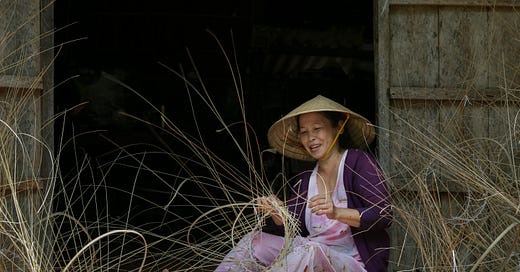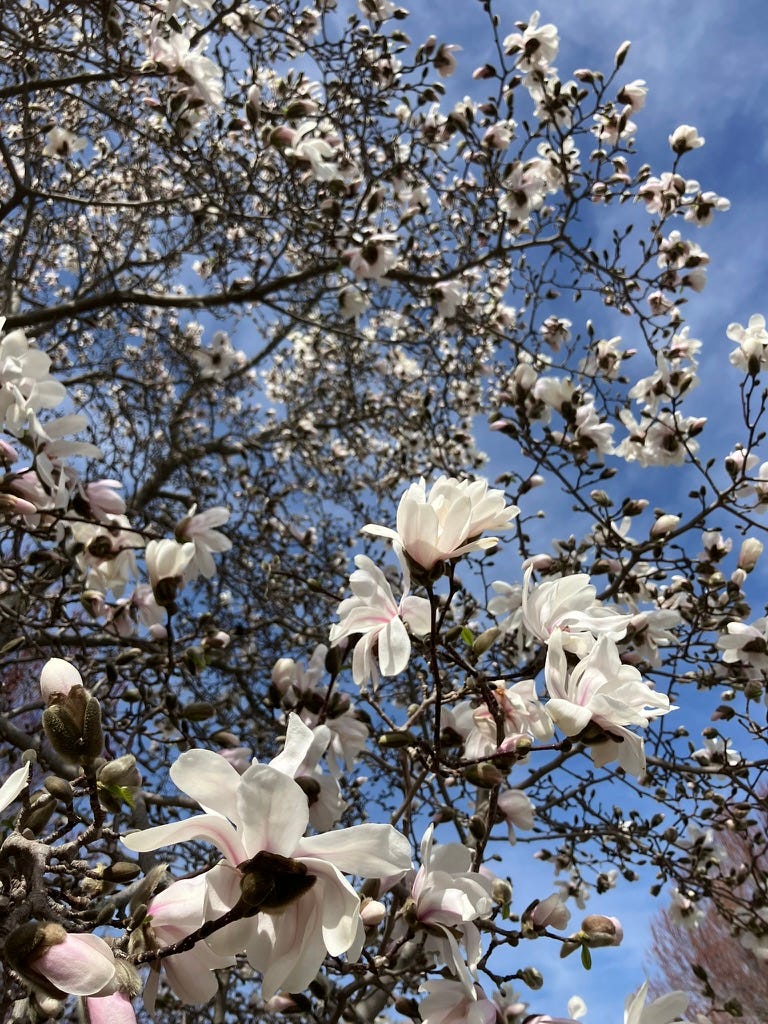How to Work with Your Hands
Maybe take up a craft, maybe convert your appendages into weapons, idk

Hi, friends!
When T. S. Eliot said “April is the cruellest month,” it was something to do with memory, desire, etc., but I think he would also have appreciated the bleakness of the five consecutive rainy weekends we’ve had here. I had to indefinitely postpone a kid’s birthday party, and I started some seeds on my balcony that, somehow, got snowed on.
But! In better news, we’ve entered flowering tree season. I have a mild obsession with cute Victorian houses in the Boston/Cambridge area that complement the colors of their dogwoods and magnolias. Our across-the-street neighbor has a weeping cherry that within the next week or two will be stopping people in their tracks.
I just looked back and realized I also wrote about flowering trees two weeks ago, which should tell you how desperately I need this.
What I’ve Been Working On
Writing pitches, mostly. And did I already tell you about the Author Questionnaire? It’s this behemoth of a survey that publishers ask authors to fill out so they can plan your marketing campaign and/or guess your passwords. Where have you lived, what do you do in your free time, what impressive people have you schmoozed with at a conference once, that sort of thing. My favorite question was “Did the book require any special research?” by which I mean it caused me to weep into my 538 endnotes.
Dear Inkfish
What are some good hobbies? I’m starting to think I need to do something with my time besides doomscrolling and making comments an in ironic tone to my dog.
—Get (me) A Hobby!
Dear GAH!,
As much as I’m sure your dog appreciates your takes, I also think hobbies are great.
Personally, I love a creative endeavor. I enjoy drawing and painting—but it can be hard to make myself dive into one of these projects, maybe because my actual work is also creative. (Peer pressure helps: I do a regular “art challenge” with several family members.)
A pursuit that, for me, works better as a hobby—which is to say, it’s fun and productive without taking much mental effort—is gardening. I’ve had a community garden plot for the past few summers and it offers a great excuse to get away from my screens or my children. (“Sorry, Daddy will get you ready for bed because I just HAVE to go tie up those tomato plants!”) Also, last summer my younger daughter’s daycare class came to visit the garden; I lifted the kids over the rabbit fence and they all trampled the strawberries and stuffed their faces with raw kale and it was pretty much the cutest thing ever.
I think a good hobby is challenging, low-stakes, and lets you work with your hands. Yes, this is where I tell you about an animal that also works with its hands—although first, it had to invent having hands at all.
The animal is called the blue sea slug. Or, more fancifully, the blue angel. It’s a kind of nudibranch, a strange squishy ocean creature.

Most of the blue angel’s relatives live on the seafloor, eating different small squishies. Their prey animals have defensive structures called nematocysts, which are tiny pouches of stinging needles. Kind of like the fiber in your bowl of Raisin Bran passes through your body without being digested, these stinging structures move through a sea slug’s body intact. But instead of becoming poop, they get transported into the slug’s own appendages.
Usually, these appendages are on a sea slug’s back. It uses nematocysts stolen from prey to defend itself against its own predators.
But the blue angel does things differently. Instead of crawling on the seafloor, it uses air inside its body to float belly-up at the surface. Its appendages, rather than being on its back, stick out from its sides.
And—researchers discovered when they studied blue angels in the lab—these slugs use their stinging appendages like arms and hands. When scientists dropped prey items into the water, the blue angels turned over, grabbed the prey with their front-most pair of appendages, and shoved it toward their mouths.
Although its relatives use their stolen stingers in self-defense, the blue angel has evolved to attack as well. This seems to have given it a more flexible diet: Unlike other sea slugs that specialize on just one kind of prey, the blue angels in the lab ate all kinds of creatures that got within arm’s reach.
Whether you find a hobby that lets you use your hands creatively or to attack something (a problem, a jellyfish), I hope you can enjoy it like the blue angel: inventively, voraciously, on top of the world.



